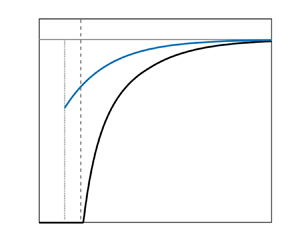Article contents
Bounds for internally heated convection with fixed boundary heat flux
Published online by Cambridge University Press: 05 July 2021
Abstract

We prove a new rigorous bound for the mean convective heat transport  $\langle w T \rangle$, where
$\langle w T \rangle$, where  $w$ and
$w$ and  $T$ are the non-dimensional vertical velocity and temperature, in internally heated convection between an insulating lower boundary and an upper boundary with a fixed heat flux. The quantity
$T$ are the non-dimensional vertical velocity and temperature, in internally heated convection between an insulating lower boundary and an upper boundary with a fixed heat flux. The quantity  $\langle wT \rangle$ is equal to half the ratio of convective to conductive vertical heat transport, and also to
$\langle wT \rangle$ is equal to half the ratio of convective to conductive vertical heat transport, and also to  $\frac 12$ plus the mean temperature difference between the top and bottom boundaries. An analytical application of the background method based on the construction of a quadratic auxiliary function yields
$\frac 12$ plus the mean temperature difference between the top and bottom boundaries. An analytical application of the background method based on the construction of a quadratic auxiliary function yields  $\langle w T \rangle \leq \frac {1}{2}(\frac {1}{2}+ \frac {1}{\sqrt {3}} ) - 1.6552\, {\textit {R}}^{-(1/3)}$ uniformly in the Prandtl number, where R is the non-dimensional control parameter measuring the strength of the internal heating. Numerical optimisation of the auxiliary function suggests that the asymptotic value of this bound and the
$\langle w T \rangle \leq \frac {1}{2}(\frac {1}{2}+ \frac {1}{\sqrt {3}} ) - 1.6552\, {\textit {R}}^{-(1/3)}$ uniformly in the Prandtl number, where R is the non-dimensional control parameter measuring the strength of the internal heating. Numerical optimisation of the auxiliary function suggests that the asymptotic value of this bound and the  $-1/3$ exponent are optimal within our bounding framework. This new result halves the best existing (uniform in
$-1/3$ exponent are optimal within our bounding framework. This new result halves the best existing (uniform in  $ {\textit {R}}$) bound (Goluskin, Internally Heated Convection and Rayleigh–Bénard Convection, Springer, 2016, table 1.2), and its dependence on
$ {\textit {R}}$) bound (Goluskin, Internally Heated Convection and Rayleigh–Bénard Convection, Springer, 2016, table 1.2), and its dependence on  $ {\textit {R}}$ is consistent with previous conjectures and heuristic scaling arguments. Contrary to physical intuition, however, it does not rule out a mean heat transport larger than
$ {\textit {R}}$ is consistent with previous conjectures and heuristic scaling arguments. Contrary to physical intuition, however, it does not rule out a mean heat transport larger than  $\frac 12$ at high
$\frac 12$ at high  $ {\textit {R}}$, which corresponds to the top boundary being hotter than the bottom one on average.
$ {\textit {R}}$, which corresponds to the top boundary being hotter than the bottom one on average.
JFM classification
Information
- Type
- JFM Rapids
- Information
- Copyright
- © The Author(s), 2021. Published by Cambridge University Press
References
REFERENCES
- 9
- Cited by


